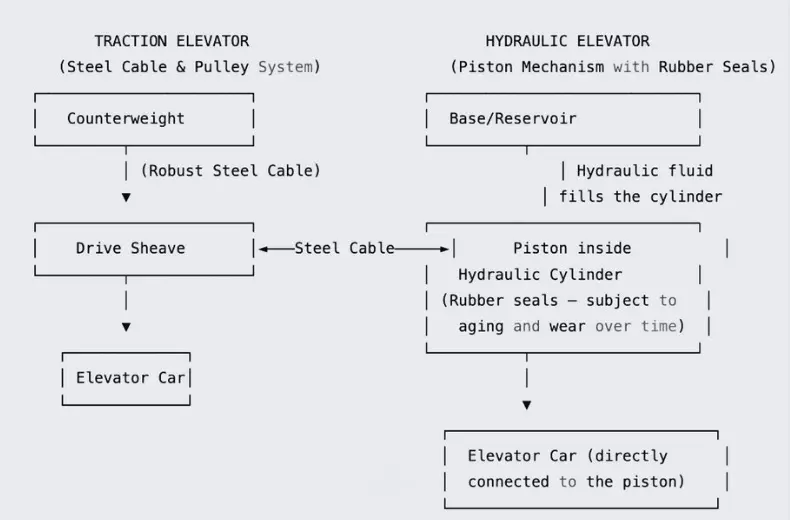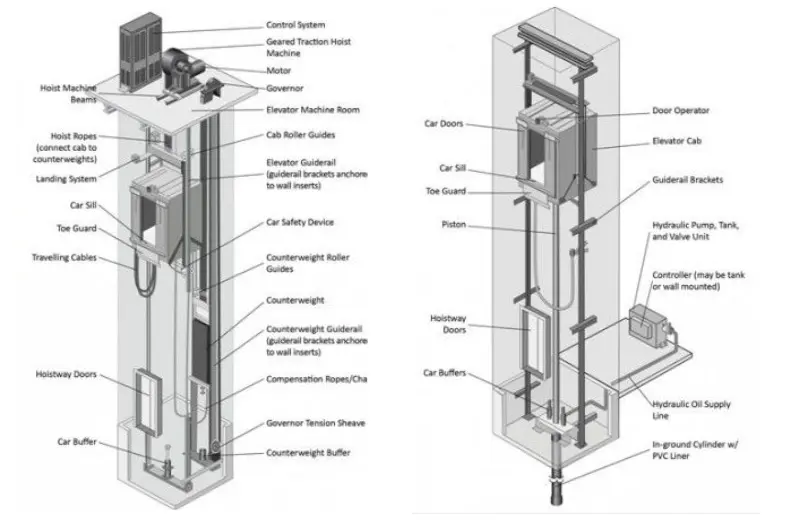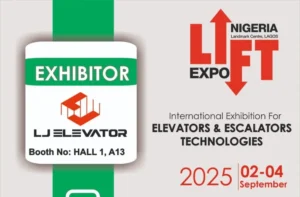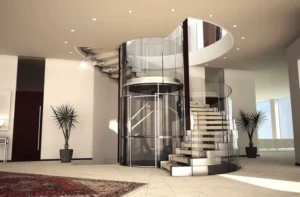In today’s booming home renovation market, residential elevators are more than a luxury—they are a smart investment in your family’s safety and comfort. While many ads promise “home elevators for just $3,000,” the truth is that many of these so-called budget options are hydraulic lifts. In China, these hydraulic systems are legally defined as “lifting platforms” because they lack the advanced safety features required of true elevators. In contrast, our company proudly offers advanced traction elevators that combine cutting-edge technology with robust safety and unmatched comfort.
Advanced core technology: traction system vs. hydraulic jack
Our traction elevators
Our elevators use a steel-rope system powered by a permanent magnet synchronous traction machine. Think of this machine as the heart of a modern, efficient car—it provides steady, smooth power to move the elevator cab seamlessly. This technology, similar to that used in commercial elevators, ensures a ride as smooth as a Ferris wheel. Multiple failsafe features are built in: an overspeed governor, safety gears, buffers, and emergency brakes that engage even if the cables unexpectedly fail. These features make every ride safe and reliable.
- Hydraulic lifts compared
Hydraulic lifts work with oil pumps that push a piston upward—imagine a large car jack at work. However, there are significant downsides: - Oil leakage issues: Hydraulic systems rely on sealing rings made of rubber. Since rubber inevitably ages, these seals can degrade and leak oil over time.
- High maintenance demands: Typically, hydraulic oil must be replaced every three years. Each oil change can cost between $5,000 and $10,000 and requires skilled personnel. Spilled oil may produce unpleasant odors and further damage the system if not handled properly.
- Basic safety mechanisms: Due to these factors, hydraulic lifts are not considered suitable for family use and are legally categorized as “lifting platforms” in China.

Traction elevator:
The system uses high-strength steel cables that loop over a drive sheave. The counterweight balances the elevator car, reducing the load on the motor. This cable-and-pulley arrangement is known for its durability and smooth performance.
Hydraulic lift:
The elevator car is lifted by a piston inside a hydraulic cylinder. Hydraulic fluid is pumped into the cylinder to move the piston upward. Over time, the rubber seals within the cylinder can degrade or “age,” which may affect performance and require maintenance.
Unmatched safety and reliability
Engineered protection you can trust
Our traction elevators are designed with your safety in mind. Here’s a side-by-side look at why our system outperforms basic hydraulic lifts:
| Safety Feature | Traction Elevator (Our Standard) | Basic Hydraulic Lift |
| Emergency Braking (Power Loss) | Triple Backup System | No backup system |
| Overspeed Protection | Dual Safety Systems | No protection |
| Freefall Prevention | Mechanical Lock | No freefall prevention |
| Door Safety Interlocks | Multi-Sensor Technology | Basic Latch Mechanism |
| Annual Inspections | Mandatory and Thorough | Not Always Required |
Recent studies have shown that hydraulic lifts can have failure rates up to 7.2 times higher than traction elevators. Every component in our elevators undergoes rigorous testing and maintenance, ensuring you and your loved ones are secure every time you ride.

Built to last
Our traction elevators are engineered to provide over 20 years of smooth, reliable service. While hydraulic systems often require the replacement of key components (like pistons) every 3–5 years—and suffer from issues like oil leakage due to aging rubber seals—our state-of-the-art technology minimizes repair needs and maximizes longevity.
Exceptional user experience and comfort
Smooth and quiet operation
Using variable frequency drives (VFDs)—similar to a car’s continuously variable transmission—our elevators start and stop gently without jerks. Noise levels remain under 45 dB, offering a quiet, comfortable ride that enhances daily living.
Superior capacity and versatility
Our elevators are designed to accommodate over 400 kg, ensuring ample space and ease of use for all family members, including wheelchair users. This high capacity sets our product apart from hydraulic systems that typically max out at 250 kg.
Reliable emergency communication
In the rare event of an emergency, our elevators are equipped with direct communication systems that instantly connect you with trained technicians. This extra layer of security is something hydraulic lifts simply cannot match.
Transparent costs and long-term value
We believe in honest pricing and long-term value. Below is a clear comparison that shows why our traction elevators are a better investment—not just in terms of safety, but also on the financial side:
| Cost Component | Traction Elevator (Our Product) | Hydraulic Lift |
| Initial Cost | $12,000–$18,000 | $3,000–$5,000 |
| Annual Maintenance | Around $2,000 | $8,000–$12,000 |
| Additional Oil Change Costs | None | $5,000–$10,000 every 3 years (plus risk of oil leakage and odor) |
| Total Cost Over 10 Years | $14,000–$20,000 | Significantly higher when factoring in extra oil changes and repairs |
While hydraulic lifts might seem attractive with a low initial price, hidden costs quickly add up. Regular oil changes, aging rubber seals, and the potential for oil leakage not only compromise safety but also lead to unpredictable and higher long-term expenses. These extra costs, along with the risk of unpleasant odors from spilled oil, make hydraulic systems unsuitable for family use.
Expert advice: 3 essential steps before purchase
- Verify certification:
Always check for a “Special Equipment Manufacturing License.” Our traction elevators proudly carry this certification (often marked with code “T”), and you can verify it on the official regulatory website. - Inspect safety components:
Look for advanced safety features like an overspeed governor, safety gear, buffers, and multi-sensor door interlocks. We encourage you to compare our elevator’s components with standard images available online. - Review testing reports:
Ensure that you receive comprehensive testing reports. Our documentation clearly shows that our product meets or exceeds the highest safety standards—unlike many hydraulic lifts, which often come with reports labeled “lifting platform.”
Following these steps will guarantee that you invest in a product that delivers uncompromised safety, comfort, and long-term value.
Why choose our LJ Elevator?
At LJ Elevator, we combine innovative technology with an unwavering commitment to safety and customer satisfaction. Our elevators are not just machines—they are a promise of quality, reliability, and enduring comfort for your home. Here’s why our traction elevators are the best choice:
- Unbeatable Safety: Our products exceed strict regulatory standards and include multiple fail-safes to protect your family.
- Superior Comfort: Enjoy a whisper-quiet, smooth ride every time with technology designed to minimize vibrations and noise.
- Long-Term Savings: With lower maintenance needs and a lifespan exceeding 20 years, our elevators offer outstanding long-term value.
- Dedicated Service: Our expert team provides comprehensive support from installation to routine maintenance, ensuring your peace of mind.
A home elevator is not merely an appliance—it’s a long-term commitment to your family’s safety and well-being. When you choose LJ Elevator, you choose a partner who shares your values and prioritizes excellence.
Conclusion
Your family deserves the best in safety and comfort. Don’t be lured by budget options that hide dangerous flaws like oil leakage and skyrocketing maintenance costs. Choose our state-of-the-art traction elevator and experience the difference in quality and peace of mind. Contact our friendly sales team today to learn how LJ Elevator can transform your home.





